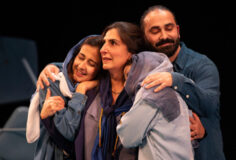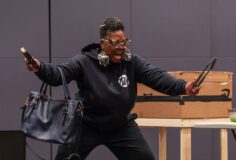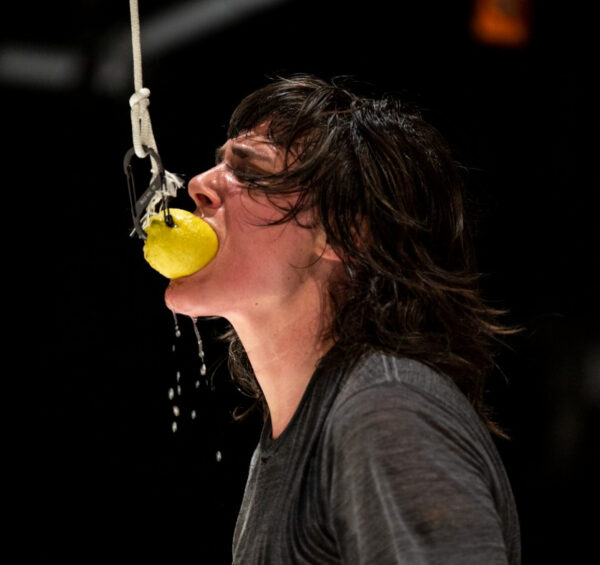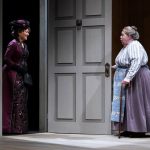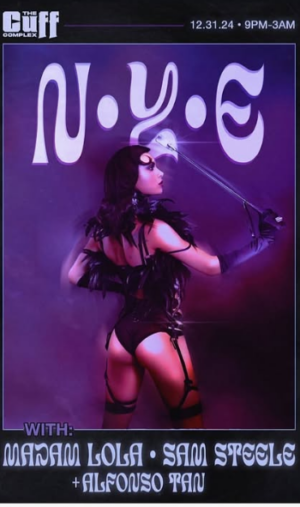Review: JOHN by Annie Baker. Produced by ArtsWest Playhouse. Directed by Erin Murray. Scenic Design by Burton Yuen. Costume Design by Ricky German. Lighting Design by Ryan Dunn. Sound Design by Dominic CodyKramers. Properties Master: Jennifer Burkley. With Suzy Hunt, Mi Kang, Sean Lally, Marianne Owen. Now through April 7, 2019 at ArtsWest Playhouse/West Seattle.
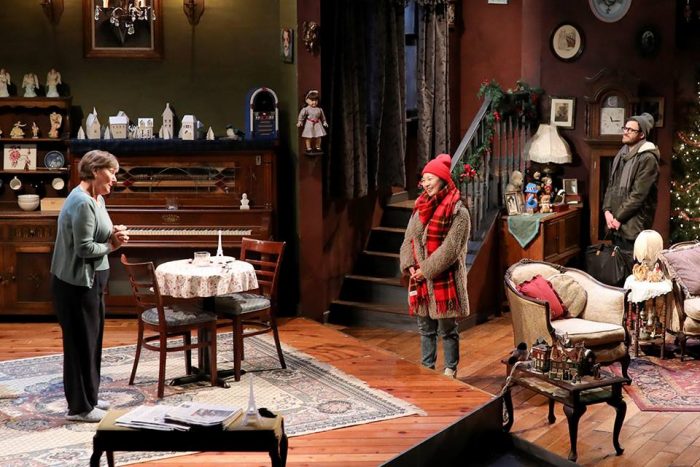
Mertis (Marianne Owen) welcomes Jenny (Mi Kang) and Elias (Sean Lally) to her B&B in Annie Baker’s JOHN onstage at ArtsWest March 14 to April 7, 2019. Photos by John McLellan
You either love a good ghost story, or you don’t.
You either love a long, specifically paced piece of theater, or you don’t.
You either love enigmatic stories with lots of odd little fleeting details that may or may not be integral to the story/stories being told, or you don’t.
You either like Annie Baker plays, or you have a terrible taste in dramatic literature.
(Kidding! Mostly…)
If you responded positively to all four of these bold pronouncements, you’ll probably very much enjoy, to one degree or the other, ArtsWest Playhouse’s current production of Annie Baker’s enigmatically odd play JOHN, now on their stage through April 7th.
If you’re ok with some and not ok with the others, then it’s a crap shoot.
If you’re not keen on any of them, you probably should just stay home and watch Fuller House on the TV while murmuring to yourself, “Oh, Aunt Becky…what have you done!??!”
Fans of Ms Baker’s plays, each one of which is seemingly more dense and more deliberately paced than the previous, tend to enjoy the uniquely organic naturalness of her work. The people who populate Annie Baker’s plays seem very real, complete with all the quirks, bigotries, hatreds and passions that every real person has as part of their personality. We/they are all capable of being very wonderful as well as very flawed. And, sometimes it’s we display our ugly sides and sometimes we display our fabulous sides and sometimes we just sit quietly, in the dark, stewing about the problems in our lives.
Those were all elements in Baker’s breakout play, the Pulitzer Prize winning The Flick, which had a successful production in Seattle a few years back, albeit a polarizing one. After all, it’s a three hour play about three young people working in a rundown movie theater. And, that’s also a big part of John which centers on a young couple named Jenny and Elias and the few days they spend in an old bed and breakfast located in Gettsyburg, Pennsylvania owned by a delightfully quirky older woman named Mertis, (but please call her “Kitty”) a few days after Thanksgiving. Jenny and Elias are returning back to Brooklyn from a holiday visit to Jenny’s family in Ohio and since Elias has been a Civil War buff since he was a child, they stop off in the town, the site of a decisive battle, so he can explore the historical sites in the area.
Jenny is not keen on this and, in fact, she’s not so keen on her relationship with Elias. The couple are not married but have been together for a few years and things haven’t been going well for quite awhile…in fact, Jenny cheated on Elias with another man, named….John. Their relationship since then has been shaky to say the least, with Elias still mistrustful of Jenny.
The fractured relationship of the pair might be considered the central plot line of John, but it’s a play that defies that easy of a description. There are other factors at play here including the creepy old house itself that’s full of tchotchkes and brick-a-brac and plenty of scary dolls. (And, Jenny has an issue with dolls, and a history with a certain doll, one of which is displayed in this house, to her horror). And then there’s the sweetly strange woman who owns it (Mertis/Kitty) not to mention the history of the house and the area and then there’s the presence of Genevieve, an elderly and rather strange friend of Mertis who also happens to be blind. Genevieve doesn’t appear until the second of the three acts of the play but she significantly changes the dynamics of the play/and the story with her larger than life personality and her tendency to proclaim very odd tales from her complicated life that has included bouts of depression and emotional illness, part of which was caused, or so she claims, by her relationship with a problematic man in her life…
Also named John.
And, yes, John (the Play) is a long piece, something much noted in all reviews/press on the play, usually with a hint of disdain if not outright anger and hostility. Long plays are not in fashion at the moment where the tendency is to be very short, contained to a single act and probably containing 4 or fewer actors. Modern theater is supposed to be short, snappy, to the point and fast paced. A classic 3 act play is seen as an indulgence and old fashioned and boring.
Of course the reality is, a good play is the length it needs to be. (If it’s well written and well produced). I’ve sat through (many) 90 minute plays that felt like I had been entombed for a century and I’ve sat through 3 and a half hour long plays that felt like 10 minutes of sheer joy had just whizzed on by. Short isn’t necessarily better.
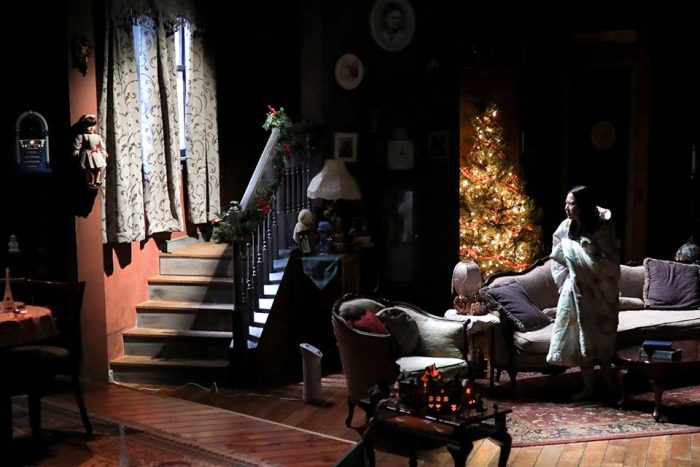
Jenny (Mi Kang) has an uncomfortable encounter with a doll in Annie Baker’s JOHN onstage at ArtsWest March 14 to April 7, 2019. Photos by John McLellan
John (the Play) consists of three almost-an-hour-long-each acts that are separated by intermissions between them. And, I’ll be honest: the first act was challenging, as we got to know the characters and the setting and the situation. There are very long stretches where the actors do not speak…in fact, there are stretches when there are no actors actually on stage! The first act sets up the story with the arrival of Jenny and Elias, followed by their first night in the bed and breakfast then their first morning. It took some getting used to, the passage of time and the pauses and the long night and the darkness. And, to be frank, Jenny and Elias aren’t the most personable pair to spend time with…they each have character flaws. They’re a tiny bit awful, each of them, in their own ways though initially Jenny seems the more reasonable of the two.
But, Act 2 is much different from Act 1. It’s livelier, mostly due to the arrival of the loud and boisterous Genevieve and the departure of Elias who is off touring Gettysburg sites by himself; Jenny has begged off claiming cramps as her excuse though it seems more likely she just wants to be away from Elias. And, Jenny does much enjoy a wine soaked afternoon/evening of hanging out with Mertis and Genevieve and dishing with the older woman and gradually revealing more of her story.
And, really, that’s a main part of John…the telling of stories. Over the course of three hours we do learn a lot about all four of the characters, though at times it’s just tantalizing bits of biographical information that may or may not be entirely true. And, we also start to notice many odd things like the fact that Jenny and Genevieve have similar names and similar “John” stories in their lives. And, Mertis (no one actually seems to call her Kitty) is a very enigmatic character; reluctantly she reveals bits and pieces of a long life, that was frequently very difficult, including a failed early marriage and the surprising nugget of information that she has a living, though ailing, husband living somewhere in the house though we never hear or see him. Mertis also reveals some history of the house including the fact it was used as a hospital during the famous Civil War battle and that piles of severed arms and legs were stacked up outside the windows where they had been tossed during the many amputations performed.
There’s also the fact that Jenny and Elias only seem to connect when he tells her ghost stories. And, the nervousness Mertis displays when she talks about certain rooms of the house, including hidden rooms…and, why does Mertis manually move the hands of the large old grandfather clock in the living room? Is she manipulating time itself? And, why do lights flicker on and off at times? Why does Mertis have a notebook written in an odd language that she claims isn’t hers, though we’ve seen her with it? Why does Jenny reveal a horrifying story about Elias’s childhood to complete strangers?
All the oddness in this play and the pauses and the stories and the weird noises and the flickering lights and the strange little bits of business and the horrible fractured relationship of Jenny and Elias all weave together into a one fascinating, complicated piece of theater and drama. Several days after seeing the play, I’m still asking myself questions about the play and things in the play and what they might mean.

Mertis (Marianne Owen), Genevieve (Suzy Hunt) and Elias (Sean Lally) in Annie Baker’s JOHN onstage at ArtsWest March 14 to April 7, 2019. Photos by John McLellan
And…I get it. Some people (me) like the weird and the odd and the silences and the darkness and for other people, it just drives them insane to sit through (I’m sure ArtsWest is getting walkaways at the first intermission…) That said, if a weird story is poorly told, it can be a chore. But, Annie Baker is a Great American Playwright. She has a gift to turn the mundane and the awkward into great works of dramatic literature, long pauses and all. She’s not afraid of silence or the dark or the ugly side of her characters…I know she loves them all. Even difficult Elias and equally difficult Jenny. (No, this is not a “let’s bash the man in the relationship ’cause it’s usually his fault” kind of story. Jenny is a very flawed human being, too.)
After devoting 1500 words to the play as a piece of drama, I guess it behooves me to say something about the specific production at ArtsWest. It’s a strong production with a good cast and some excellent design work including a handsomely cluttered set by Burton Yuen and appropriately mysterious lighting by Ryan Dunn and subtly pervasive sound design by Dominic CodyKramers (though an offstage conversation does need to be a bit LOUDER so us old folks can hear it…) and this is definitely a production where you need to give out some love to the props person, in this case Jennifer Burkley, because this is a show with a huge list of problematic props to be acquired. And, nicely costumed by Ricky German because, why leave him out just because it’s a modern dress show and “easy” to costume. (Note: I’m being sarcastic; modern dress does not equal “easy” for a costumer. Ever.)
My only major critique of the play might be in its direction by Erin Murray; it meanders a bit. There are times where it feels the actors are just doing their own thing and that’s not necessarily good. There’s a lack of cohesiveness where things don’t feel in sync with one another; actors at different and conflicting levels of emotion and intensity and even volume.
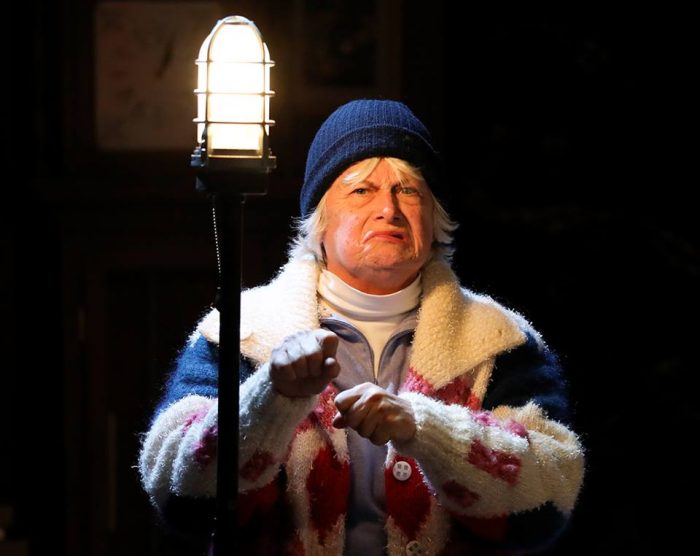
Suzy Hunt as “Genevieve” in Annie Baker’s JOHN onstage at ArtsWest March 14 to April 7, 2019. Photos by John McLellan
The cast is strong though with Suzy Hunt being a bit of a scene stealer as the “big personality” character of Genevieve. Ms Hunt is very good at playing these kinds of roles and if you give her the material (and a lack of restraint) she’ll run with it. She and her character give the production a lot of energy and life. It’s a fun role and fun performance.
Marianne Owen’s character of Mertis/Kitty is the glue that really holds the play together and it’s the most fascinating of the four, in my opinion. Who IS this woman? There’s so many different aspects of the character and they’re all revealed in small increments…it’s like a tantalizing emotional striptease where there’s never very much revealed…so much is still hidden away. And, what’s even odder is the fact that veteran stage and television actress Georgia Engel originated this role in New York. Engel is best known as the baby voiced, shy Georgette from the 1970s television sitcom classic The Mary Tyler Moore Show and while Ms Engel has had a 50+ year career in show business, delighting millions of people over the years, she really only has THAT voice…the baby doll breathiness that is her ACTUAL voice. She really is “Georgette” and that’s the type of role she’s consistently played over the decades and yet that’s not obviously Marianne Owen’s voice so it’s odd to picture Georgia Engel playing Mertis, while watching Marianne Owen claim a role so successfully played by a very different actress, (Engle received rave reviews and an Obie Award for her performance). Ms Owen’s Mertis is also an “innocent” but she’s an earthier sort…her Mertis feels more rooted in the earth than the air. It stabilizes this odd house and this odd play.
As for the “kids” at the heart of John, they really have the toughest roles…it’s not easy playing vaguely jerkish millennials as the center couple of a play and especially a pair that can be more disliked than not. And, that affects how we see the actors playing the roles as well. Are the actors giving “bad performances” because they don’t seem to have any chemistry with each other when the characters are actually supposed to be two people who ARE mismatched and have no business being with one another? They’re like those friends you have that you like individually but when they couple up, you can’t stand them; they bring out the worst in one another.
Here, it’s talented and established local actress Mi Kang as Jenny and Seattle area newcomer Sean Lally as Elias and they do seem like a terrible pairing. They bicker and mostly resent each other…there are waves of hostility between them. At their first breakfast in the B&B, Jenny cringes watching Elias slurp his cereal and he notices it and confronts her and accuses her of being anti-semitic and the two fight. But, it’s all in the writing…they’re supposed to be an awful couple. And, both actors are very good at conveying that, which can’t be easy for the actors as well as confusing to an audience. We’re supposed to be conflicted about Elias and Jenny…right down to the last line of the play which sums up their horrible relationship.
No spoilers!
Go back to the beginning of this three hour long review and re-read my list. If you like this kind of play, then you must see John.
If you don’t, there’s always Fuller House eps to re-watch on Netflix.


